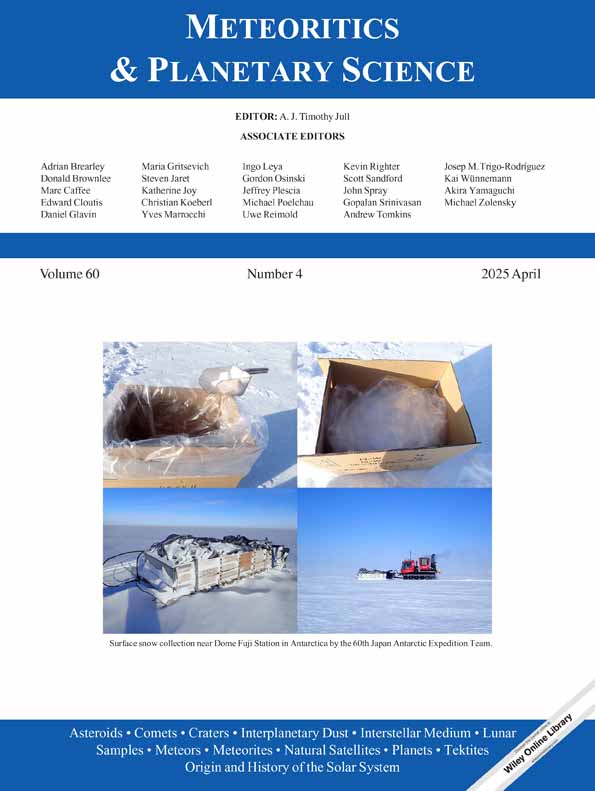Microfaults: Abundant shear deformation and frictional melting in chondrites
Editorial Handling—Dr. John G. Spray.
Abstract
The majority of ordinary chondrite (OC) meteorites record some amount of textural evidence for impact-induced deformation. Melt veins in some shocked samples have been compared to terrestrial impact-related pseudotachylites, which form by frictional melting of host rock. However, lacking in situ context, the role of friction in driving impact-related melting in meteorites remains unclear. Here, we present evidence for an important role for shear deformation and friction in complementing shock melting of OC material. We find microfaults directly associated with textural evidence for quenched frictional shock melt in samples of a broad range of bulk shock stages and across all three classes studied (LL, L, or H). Microfaults occur in 20% of our studied samples. We identify examples of both individual microfaults and, in rare cases, microfault networks, complete with subsidiary shear structures. Our observations indicate that friction plays an important role in melt generation in weakly to moderately shocked samples and may also be relevant for strongly shocked meteorites. Microfault structures may be of underestimated significance in chondrites in general—both with regard to their general abundance and their possible utility for elucidating the geological settings sampled by meteoritic impactites.
INTRODUCTION
Chondritic meteorites sample primitive asteroidal material, that is, material that did not experience igneous differentiation (Scott, 2007). The ability to decipher the geological histories of chondritic asteroids via meteorites would allow us to access invaluable records of solar system history. However, these records are complex and thus difficult to interpret. Chondritic parent bodies appear to have experienced extensive alteration and metamorphism—textural and chemical evidence for which points to a mixture of thermal, aqueous, and shock-induced metamorphic pathways having affected individual meteorites (Dixon et al., 2004; Hanan & Tilton, 1985; Jones et al., 2014; Ruzicka et al., 2015; Yin et al., 2014). However, correctly interpreting the evidence for these pathways is confounded by an inherent problem with meteorite sampling of asteroids: a lack of geological context.
The challenge posed by the paucity of in situ chondritic asteroid samples is exemplified by shocked meteorites. Shocked meteorites span a range of assigned stages: from S1 to S6, based on textural observations that are diagnostic of distinct shock pressures or durations (Stöffler et al., 2018). However, this approach does not always directly inform us where two petrologically similar samples of an equivalent shock stage lay within their parent asteroid relative to impact loci. That is, observational constraints from some shock-induced features may be degenerated between different settings and types of event. In this way, the systematic assessment and interpretation of as many shock indicators as possible is needed to help us untangle the problem at hand (Fritz et al., 2017).
The importance of context can be understood with some examples. Consider a subsample of a chondritic melt breccia that contains quenched melt. This sample might be naively classified as a melt rock. However, we know from the meso-scale context of the meteorite that melt veins are only one component of the rock; that it preserves a large volume of shocked but un-melted host rock. Diagnosing between the two possibilities without the context of the hand sample might still be possible. For example, one could search for high pressure phases, for example, wadsleyite, ringwoodite, and other polymorphs of olivine (Stähle et al., 2022), which are less commonly preserved in larger volume shock-induced melt regions than in thin rapidly quenched veins (Hu & Sharp, 2022). This example of degeneracy in interpretation only compounds as we move to larger scales.
For example, weakly to moderately shocked meteorites may represent the products of low velocity impacts or have formed at some distance from the locus of a high velocity impact (Beck et al., 2005; Bland et al., 2014; Davison et al., 2012, 2013; Jutzi et al., 2015; Moreau et al., 2019). Distinguishing between each possibility requires a detailed understanding of the scale-dependent consequences of shock wave duration/pressure and resulting shock and post-shock metamorphic effects, which is hugely challenging. Similarly, it is challenging to determine whether meteoritic impactites are autochthonous (formed in-place), allochthonous (formed after transport—either during ballistic transport on the source body or following lofting into space and subsequent re-accretion), or in between (par-auto/allochthonous). Until we can robustly identify the geological settings of shocked meteorites, the records of solar system history they preserve will be clouded by a layer of persistent uncertainty.
One way to make progress with the challenge of contextualizing shocked meteorites is to systematically categorize, classify, and interpret the specific formation conditions of shock-related features in meteorites. Many but not all such features are currently assembled in shock stage schemes (Fritz et al., 2017; Stöffler et al., 2018). Here, we focus on a category of shock features that are sometimes noted in studies of shocked meteorites (Greshake et al., 2013; Hutson & Ruzicka, 2010; Treiman, 1995, 1998) but have yet to be systematically incorporated into meteoritic shock stage assignment: microfaults.
Here, we define chondritic microfaults as the end result of shear deformation in a chondritic rock at scales of 10s–1000s of μm, resulting in textural evidence of shear sense in thin section, that is, displacement of phases lying either side of the fault plane (Figure 1a). Chondritic microfaults may occur individually or as part of a network of overstepping subparallel microfaults with possible adjacent shears; termed Riedel if sense of displacement is shared with the primary microfault, and antithetic Riedel if opposite (Figure 1b) (Davis et al., 2000). Slip on a microfault plane may induce frictional melting, being closely analogous to the formation mechanism of some pseudotachylite impactites in terrestrial impact craters (Melosh, 2005; Reimold, 1995)—simply at a smaller spatial scale. Microfault formation may accommodate processes such as block rotation and in situ brecciation (Zuza et al., 2019). These processes alongside microfault propagation shape the geometry and accommodate the formation of melt pools, veins, and dikes, in which numerous high pressure indicator phases may form (Stähle et al., 2022). As such, microfaults are intimately related to the full complement of shock-related features that we use to classify and interpret shocked meteorites.
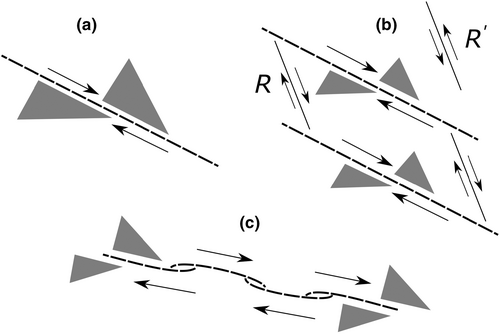
Recent experiments demonstrate that shear deformation is capable of inducing frictional melt veins and accommodating microfaults from as low as stage F-S3 in experimentally shocked granite samples (Hamann et al., 2023). This advance forces us to reconsider the shock pressures recorded by some materials, providing great impetus to reconsider the evidence for shear-related deformation in meteorites. Using a combination of transmitted and reflected light optical microscopy and scanning electron microscopy (SEM), we searched for shear-sense displacement of mineral grains/assemblages, along with associated textural evidence of melting at various scales, in a suite of shocked ordinary chondrite (OC) meteorites (S1–6). We find that evidence for displacement along microfaults is commonplace in shocked meteorites of all shocked stages, suggesting that these features stand to provide their own unique set of constraints on asteroidal shock metamorphism.
MATERIALS AND METHODS
Samples were characterized using a combination of optical microscopy at the Universidad Católica del Norte and optical microscopy combined with SEM imaging at the University of St Andrews and the University of Cambridge. We collected secondary electron (SE), backscattered electron (BSE), and cathodoluminescence (CL) images. At the University of St Andrews, samples (NWA 11744 and NWA 11745, only) were imaged with an FEI Scios DualBeam FIB/SEM using a 15 kV accelerating potential and ∼0.1 nA probe current. At the University of Cambridge, samples were imaged with a Quanta 650 SEM equipped with a panchromatic cathodoluminescence detector. SEM imaging was conducted using conditions ranging from 7 to 15 kV accelerating potential and a 120 μm field aperture in high-current mode (∼4 nA probe current).
We surveyed 49 ordinary chondrites, identifying microfaults to study in detail in 10 polished thin sections spanning shock stages S3–6 and three OC parent bodies types (H, L, and LL): NWA 11744 (L5, S4), NWA 11745 (L5, S4), Chelyabinsk (LL5, S4-6), Château-Renard (L6, S5), Alfianello (L6, S5), Monze (L6, S4), Wiluna (H5, S3), Kingfisher (L6, S6), Chiang Khan (H6, S3), and DaG 242 (H6, S4). For further information, see Table 1, constructed using shock stage scheme of Stöffler et al. (1991). These samples were selected from the collections of the Natural History Museum of London and the Natural History Museum of Vienna, Open University.
| Sample | Shock stage |
|---|---|
| Cambridge suite | |
| NWA11744 (L5) | S3a |
| NWA11745 (L5) | S3a |
| Chelyabinsk (LL5) | S4–6 (Morlok et al., 2017) |
| Château-Renard (L6) | S5 (Baziotis et al., 2017) |
| Alfianello (L6) | S5 (Gattacceca et al., 2014) |
| Monze (L6) | S4 (Xie et al., 2001) |
| Wiluna (H5) | S3 (Bischoff et al., 2018) |
| Kingfisher (L6) | S6 (Bennett & McSween, 1996) |
| Chiang Khan (H6) | S3 (Bischoff et al., 2018) |
| DaG 242 (H6) | S4 (Xie et al., 2001) |
- a Samples classified as part of the present study.
In all cases, microfault textures were identified by eye during the session. Criteria used for microfault identification universally included evidence for displacement with shear sense and extended to include the presence of frictional melt products: quenched glasses filling fractures; thin veins of material formed from partial melting of individual grains; and liquid–liquid + solid–liquid immiscibility textures. See Figure 4 for examples of all these textures.
RESULTS
Occurrence Rate of Microfaults
Figure 2 plots the observed occurrence rate of microfaults versus the sampling statistics of our survey. Having found 19 microfault-bearing meteorites, our study vastly increases the number of reported microfault occurrences. The total microfault occurrence rate in samples studied so far is 20.4%. Meanwhile, the occurrence rates for H, L, and LL meteorites are 17.6%, 23.1%, and 20%, respectively. We can estimate the robustness of these figures by resampling the current survey data with replacement over 1000 iterations (Figure 2). The estimated mean from resampling with replacement for total OC microfault occurrence rate is 20.4% ± 1.6 (2 SE); meanwhile, the resampled mean values are 17.6% ± 4.5% for H, 23% ± 3.2% for L, and 16.6% ± 12.4% for LL chondrites.
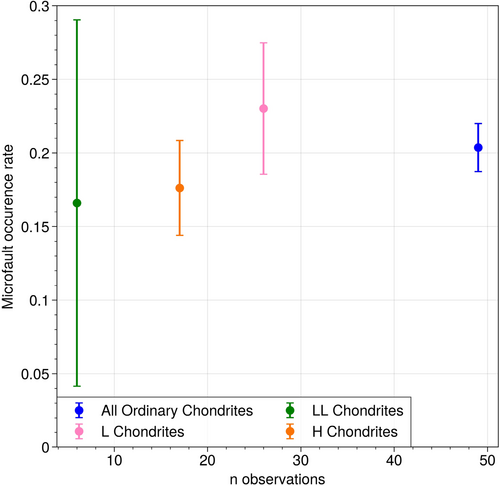
Despite the limitations of our present study, given the estimated error bars of each observation assessed with sampling by replacement, we can see that L and H chondrite microfault occurrence rates are likely to be meaningfully different (Figure 2). Our present results allow us to constrain the overall microfault occurrence rate in OC meteorites to be roughly 20%–50%, with some evidence of intergroup variation that should be considered with caution. Future work should seek to explore the relationship between meteorite type, petrologic type, shock stage, and microfault occurrence rate.
Textural Occurrences of Microfaults in Each Sample
We subdivide our microfault observations as follows: brittle only, frictional melt-associated, and melt-accommodated. Brittle-only microfaults display no evidence of shock melting along their trace in thin section. Frictional melt-associated microfaults have quenched melt products along segments the fault trace (Figure 3a,b). These melt products are preferentially iron- and iron-sulfide-dominated (Figure 3e,f), with some cases of silicate-rich shock melt with quenched immiscible iron and sulfide droplets (Figure 3f). Silicate-rich melt products are typically accommodated not long the length of the fault trace but in restricted overstep zones (Figure 3b,e,f). Finally, melt-accommodated faults show much larger melt volumes on one or both sides of the fault trace (e.g., Chelyabinsk, Figure 3d). Often, the total amount of displacement is difficult to discern in these cases.

For each of the microfault classes defined above, we observe great variability in their apparent extent in thin section. In many cases, microfaults extend only over several hundred micrometers (Figure 3a,c) before no longer being visible. While thin sections offer only a partial view of the structure, it appears that many such small-scale microfault systems may be structurally complete, that is, encompassing the entire diversity of processes associated with fault initiation, propagation, and dying out. In other cases, microfault traces are much longer, for example, longer than thin section itself. NWA 11745 is—so far—a unique specimen in that it preserves a remarkably well-developed set of shear-related microstructures. A single microfault cuts across the entirety of the sample thin section (around 50 mm; Figure 4). This largest microfault is associated with sets of Riedel shears, developed at an angle to the plane of the main microfault (Figure 1). Close examination reveals that the primary microfault, in fact, consists of a series of overstepping subparallel fault segments (Figure 4).
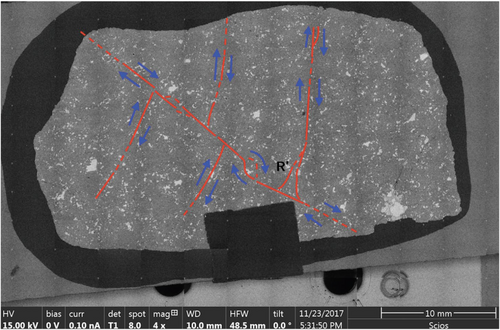
DISCUSSION
Are Microfault Textures Rare in Shocked Meteorites?
Microfaults are not presently included as a shock indicator in the commonly cited shock stage schemes (Fritz et al., 2017; Stöffler et al., 1991, 2018). As a result, microfaults may be recognized but not systematically recorded, giving rise to a perception that microfaults are rare. Here, we argue that this status quo should change, since our results indicate strongly that microfaults are both common and highly relevant for shock processes. For example, there are many studies focusing on the unusual physicochemical conditions involved in shock-induced polymorphism in meteorites that do not discuss either in detail or sometimes at all the likely contribution by the friction generated along slip surfaces (Hu & Sharp, 2017; Li and Hsu, 2018a, 2018b; Wu and Hsu, 2018). We find that microfaults are relatively abundant at least in OC meteorites and should therefore be systematically considered alongside other shock indicators. The role of friction in generating melt and in determining the local P–T–t paths followed in melt veins should be explicitly considered, emphasizing the distinction that should be drawn between vein-specific and bulk rock shock processes.
We have reported microfaults in 19 OC meteorites. Our results indicate ~20.4% for the occurrence rate of microfaults in OC meteorites. However, microfaults are sometimes challenging to identify. Moreover, their spatial distribution is clearly heterogeneous and may only be partially, or indeed, randomly sampled by particular stones, and hence, thin sections of a meteorite. Given that we had access only to single thin sections of each meteorite, the actual occurrence of microfaults per meteorite may be higher than the lower limit estimated here. Therefore, far from being rare, our results show that microfaults are fairly common and may even be pervasive (i.e., at least one example in any given main mass sample) in OC meteorites.
Shock Melt Veins are a Form of Pseudotachylite
Many shocked meteorites are described as monomict breccias (Bischoff et al., 2018). A key mechanism of grain size reduction that operates to form monomict breccias is cataclasis, producing a range of sizes of angular host rock fragments rock in a matrix of smaller such fragments (Woodcock & Mort, 2008). However, this description seems to be a poor fit for many shocked chondritic meteorites. Weakly shocked chondritic meteorites are indeed commonly observed to have been reduced to discrete and angular blocks (Bischoff et al., 2006). However, it also appears that this may not necessarily have been directly achieved by cataclasis. Instead, blocks are separated by narrow, discrete, often quenched veins of melt (Bogert et al., 2003).
Our observations show that these vein types, which first develop at low shock stages, are accompanied in many cases by evidence for displacement and therefore can be readily classified as microfault-associated pseudotachylite. Indeed, this conclusion is consistent with previous assessments that shock melt veins in meteorites are S-type pseudotachylite, which is thin (<2 mm), with minimal offset (≪5 mm), and often contain high pressure phases (Spray & Biren, 2021). The presence of melt trails of individual mineral grains within melt veins in our samples (Figure 3) provides a further shear sense indicator and provides clear evidence for frictional melting along the fault plane. This mechanism would be identical to that proposed previously on the basis of similar features formed in high strain rate meteorite deformation experiments (Bogert et al., 2003) and is overall consistent with previous assessments on the basis of textural evidence (Spray & Biren, 2021). However, an implication of the evidence for frictional melting that we provide is that this component of melting must be explicitly modeled in simulations of asteroid collisions. Currently, this is the case in only a limited number of studies that mostly focus on meso-scale rather than macro-scale shock processing of asteroids (Moreau et al., 2018, 2019; Moreau & Schwinger, 2021).
In rare cases, multiple intersecting slip planes are identifiable in a single meteorite sample, for example, as in the thin section sample of NWA 11745 studied in this work (Figure 4). Given that the angle of adjacent shears, length of displacement, and spacing of oversteps must all encode some information about the shear stresses and timescales of deformation imposed on a rock, observations such as these may in future allow us to pinpoint which geological settings in asteroidal impact craters are consistent with the presence of particular microfault structures in a given sample.
Implications of a Par-Autochthonous Classification for Many Shocked Meteorites
On the basis of evidence for in situ brecciation coupled to the formation of microfaults, the overall geological context of these shocked meteorites may be par-autochthonous or autochthonous and not allochthonous, that is, involving little or no transport prior to lithification (Figure 5). This conclusion is not so surprising or controversial but is nonetheless important, since it has broad implications for how we envisage the formation of rubble pile asteroids.
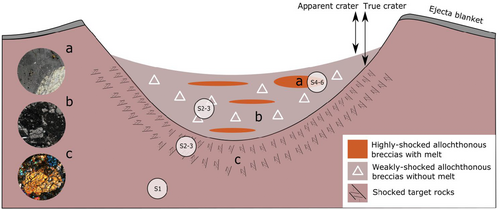
Our understanding of parent body asteroid structures has undergone a shift in recent years. It is now observed that many asteroidal bodies are rubble pile structures, comprising gravitationally bound fragments of various sizes that were once part of a cohesive whole (Asphaug et al., 1998; Barnouin et al., 2019; Blackburn et al., 2017; DellaGiustina et al., 2020; Taylor et al., 1987; Walton et al., 2023), and for which an earlier sequence of disruptive collisions appears necessary to explain. It is here that we can identify an important conundrum in meteoritics that links directly to understanding parent body evolution.
Most (monomict) meteorites are themselves generally cohesive and seem to lack textures that would imply significant transport of the constituent materials. Even strongly shocked meteorites lack strong evidence, for example, flow layering, as occurs in suevite (impact-derived and allochthonous) breccias on Earth (Bischoff et al., 2018; Bischoff & Metzler, 2006; Johnson & Melosh, 2014; Kimura & Yamaguchi, 2022; Krzesińska et al., 2015; Rubin, 2015). Shocked meteorites further lack much evidence of gravity-based density segregation during settling, as might be expected during a disruption event. Extremely rare examples of this are recorded in some cases of finely mineralogically layered chondrites (Garvie et al., 2017), but this appears to be quite a separate textural occurrence to the majority of shocked meteorites.
These observations are all consistent with the hypothesis that most monomict meteoritic breccias formed essentially in place, within a parent body that was not disrupted—at least to that depth—during the relevant collisional event. However, we must also reckon with the fact that, despite these observations, most parent bodies are observed to be rubble piles (Asphaug et al., 1998; Barnouin et al., 2019; Blackburn et al., 2017; DellaGiustina et al., 2020; Michel et al., 2020; Ryan & Melosh, 1998; Taylor et al., 1987; Walton et al., 2023). The question therefore arises: Why is there seemingly a paucity of textural evidence for the transport and reaggregation events presumably necessary to form rubble piles in derivative shocked meteorites?
One explanation might be that—consistent with some recent geochronological studies (Walton et al., 2022)—the collisional events recorded by the most obvious shock-induced features of monomict brecciated meteorites took place prior to and indeed were necessary prerequisite steps for rubble pile formation. Reduction of formerly cohesive chondritic rock types into fractured, faulted, and melt-bearing complex rock types may have paved the way for rubble pile formation during subsequent events of relatively low velocity. This could have been achieved by weakening of the original parent body structure during brecciation.
Indeed, brecciated meteorites are observed to be mechanically weaker than unshocked isochemical meteorites of the same petrologic type (which itself otherwise generally correlates positively with compressive strength) (Flynn et al., 2018). Most models of the formation of rubble pile parent bodies via catastrophic single collision disruption of pre-existing bodies assume that the original material can be well approximated by a monolithic block of basalt (Michel et al., 2001, 2003, 2020). Our work suggests that future modeling work should consider specific structural weaknesses, such as microfaults, that were likely introduced to original parent bodies by early collisions. Such weaknesses may have played an important role in determining the boundary conditions that allow for rubble pile parent body formation.
Over time, repeated ejection of material near the locus of impact would be combined with processing of deeper material into weakly to moderately shocked lithologies, resulting in a high-volume abundance of microfault-rich material deeper in the asteroid (Figure 5). This relatively weak material would then be prone to disruption during even relatively low-energy collisions, forming rubble pile structures, and then go on to be preferentially sampled in later collisions (Figure 6). This model, while speculative, would appear to be supported on several fronts by our observation that microfaults are abundant within monomict chondritic impact breccias.
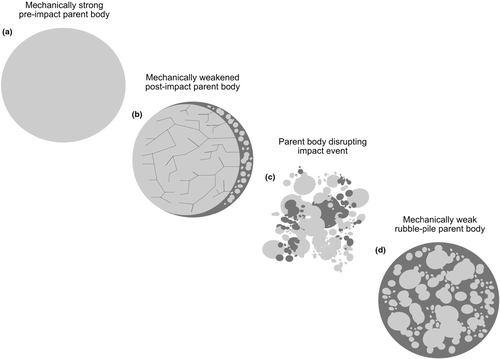
An important caveat to this general picture is that the generation of large volumes of melt will bond fragments together, thereby offsetting the weakening introduced by cataclasis/comminution, and strengthening the rock REF. However, since the volume of melt is very small relative to the volume of shocked but unmelted rock REF, we can expect the mechanism described above to be dominant in determining the directionality of the effect of microfault propagation on asteroidal strength.
Future work should examine the general prevalence of microfaults in meteorites, expanding the search to achondrites as well as carbonaceous and enstatite chondrites, and beyond. In our view, shock classification schemes should include the presence/absence of microfaults as standard, along with information on the presence/absence/volume of melt formed via friction, and the length of displacement observed. All of this information should be systematically collected alongside observations of other shock indicators and then, in future, used to help constrain the formation conditions of shocked meteorites and the geological histories of parent asteroids. This task can be informed to a great extent during the simple and routine optical microscope petrography studies that are necessary for meteorite classification. However, since thin sections offer only a 2-D slice to assess, more complex work such as 3-D tomography would be needed to fully assess true rather than only apparent displacement lengths.
CONCLUSIONS
Microfaults are generally not widely noted in the study of meteorites. However, given the proposed role of friction in the origin of shock melt preserved in some samples, their occurrence is significant in the context of the genetic interpretation of meteorite impactites. Here, we show that microfaults are in fact quite abundant in ordinary chondrite meteorites. Microfaults are found associated with melt veins in many weakly to moderately shocked meteorites, and some displacement—if not clear-cut microfault planes—can also often be identified across larger melt veins in highly shocked meteorites. It appears likely that microfaults occur in many shocked meteorites but may only be identified if examining a thin section that happens to intersect a fault plane. Given the heterogeneous nature of chondrites, we propose that microfaults may occur regularly but at low spatial density—explaining the lack of widespread reporting—in most meteorites. We expect that reporting rates may also increase if microfaults are explicitly included in the systematic schemes that exist to classify the shock stage of meteorites, leading to more researchers actively searching for and cataloguing their occurrence. We highlight that the unique P–T–t paths of shock melting associated with the development of microfaults may provide a relevant body of evidence with which to test genetic models of meteorites, for example, crater-floor versus crater-fill origins.
Acknowledgments
This project started life in 2016 during a Paneth Trust internship at the Open University in Milton Keynes (UK). There are therefore many sources of funding support to acknowledge. C.W. acknowledges funding from the NOMIS foundation and ETH Zürich, the Paneth Trust, NERC and UKRI for support through a NERC DTP studentship (grant number NE/L002507/1), support from the Cambridge Leverhulme Centre for Life in the Universe, funding from the MACEI grant program, and funding from Trinity College in the form of a Junior Research Fellowship position. Dr David Miller along with the wider staff of the Electron Microscopy Facility at the University of St Andrews as well as Dr Nicola Potts, Dr Mahesh Anand, and Dr Richard Greenwood are all thanked for their support during the earliest stages of this project in 2017–2018. We thank both reviewers (Dr Alex Ruzicka and Dr Ross Findlay) and Associate Editor Professor Spray for their detailed, informative, and constructive input during the review process of this article.
Open Research
Data Availability Statement
The data that support the findings of this study are available in the supplementary material of this article.



